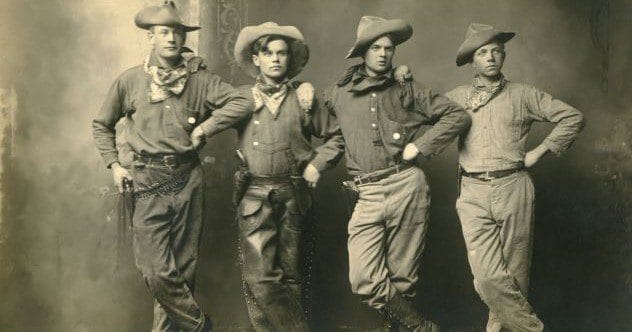Cowboys, with their rugged charm and tales of the Wild West, have long captured our imaginations. Armed with six-shooters and sporting wide-brimmed hats, they represent coolness and heroism. But how much of what we know is true? Get ready to unearth the real lives of cowboys, filled with unexpected twists and turns!
Let’s dive into ten astonishing and unexpected facts about the true pioneers of America’s untamed western frontier. Prepare to have your cowboy beliefs challenged!
A Horse of a Different World
Think cowboys always rode horses? Think again! While horses were part of their lives, many cowboys didn’t rely on them as much as you’d expect. The harsh winter of 1885 changed things, devastating livestock and forcing ranch owners to keep animals closer to home.
The days of long cattle drives diminished as urban areas expanded and the need for the old ways faded. Cowboys transitioned from riding hard to staying close and mending fences.
Though stories of cowboys bonding with horses are legendary, many horses weren’t even their property. They were often owned by the ranch owners, like a company car perk in the 19th century.[1]
Cowboys Had Camel Culture
Camels in the Wild West? Absolutely! The U.S. government introduced camels to Arizona to see if they could handle the desert climate like they did in the Sahara. Private importers also brought camels to California and Nevada.
The Civil War disrupted the government’s experiment when Confederate soldiers raided a camp and released the camels. Landowners used these stray camels on farms and ranches, offering a unique alternative for cowboys without horses.[2]
Vicious, Vicious VD…
Cowboy life wasn’t always clean. Cowboys were often filthy, rarely bathing by modern standards. But the real issue was the prevalence of sexually transmitted diseases.
Historians estimate that a significant percentage of prostitutes in Old West towns had venereal diseases, spreading them to cowboys who visited brothels and saloons. This created a vicious cycle, worsened by limited medical knowledge.
Treating these disorders was challenging, and the spread was significant. It’s safe to say that many cowboys suffered from these conditions.[3]
Trysts on the Range
The movie Brokeback Mountain shocked audiences, but homosexual behavior among cowboys was more common than expected. The job’s nature, with long periods of isolation, led to men meeting their needs with one another.
Historians have uncovered love poems written between cowboys. Living outside societal norms allowed them to express their feelings more freely.
Lonely cowboys found solace in each other, and some closeted gay men reinvented themselves on the range. It wasn’t every cowboy, but it was common enough to be a known part of frontier life.[4]
A Gun-Free Gig
The image of an armed cowboy is iconic, but real-life cowboys weren’t always gunslingers. Their duties involved building fences, driving cattle, and tending livestock, which didn’t always require weapons.
Many Old West towns outlawed guns. Sheriffs enacted gun control, and even notorious outposts like Tombstone, Arizona, banned firearms. Cowboys avoided trouble with the law, so they usually disarmed themselves.[5]
Instagram Influencers of the Old West?
Outlaws in the Old West were the Instagram influencers of their time. They bragged about their exploits and used the cowboy image to promote themselves. Figures like Jesse James inflated their robbery counts and daring escapes.
Billy the Kid also engaged in mythmaking, exaggerating his kill count. While real cowboys were busy with their work, outlaws stole their valor and used cowboy culture for their own glory.
This self-promotion helped solidify the cowboy lore in mainstream culture.[6]
Support from WHERE?
Germans have a significant fascination with the Old West. For a century, they’ve followed the exploits of cowboys and frontier homesteaders. Modern Germany has private clubs where people dress up as cowboys and reenact frontier life.
Even Adolf Hitler was obsessed with cowboy culture, viewing them as the embodiment of true masculinity. He enjoyed westerns and read cowboy books in his spare time.[7]
They Couldn’t Get No Respect
Despite their current respected status, cowboys were once viewed as poorly educated drunks and vagrants. Ranchers often distrusted them and avoided hiring them.
Their duties, like driving cattle through farmers’ fields, caused damage and resentment. Cowboys were seen as mean, rude, smelly, and disease-ridden.
As the West was won, writers romanticized the past, transforming cowboys into rugged heroes. This carefully crafted image is how the world now knows them.[8]
Don’t Fight, Friends!
The Old West was less violent than you think. Bank robberies and shootouts were less common than portrayed. One study showed more bank robberies in a modern city in a year than in the Old West in a decade!
Living in rural areas required cowboys to get along with their neighbors. Life was hard, and cooperation was essential. The ideal of a lone cowboy was far from reality.
Maintaining good relationships with neighbors was crucial for survival in the challenging Wild West.[9]
They Weren’t All White
Popular culture often portrays cowboys as white, but up to 25% of cowboys in the 19th century were Black. A similar percentage were Hispanic, and Native Americans also contributed.
Landowners needed all the help they could get, regardless of race. While expansion happened before the Civil War, it exploded afterward, with ranchers eager to move on.
Black cowboys still faced racism but had more autonomy than Black citizens back east. They often did the hardest jobs, but they also gained respect. This led many former slaves to push west after the Civil War.[10]
Conclusion
The cowboy image is filled with myths and realities. From riding camels to facing diseases and social stigmas, their lives were far more complex than the legends suggest. Understanding these truths provides a richer view of the pioneers who shaped the American West.
What surprised you most about these cowboy facts? Leave your comment below!










